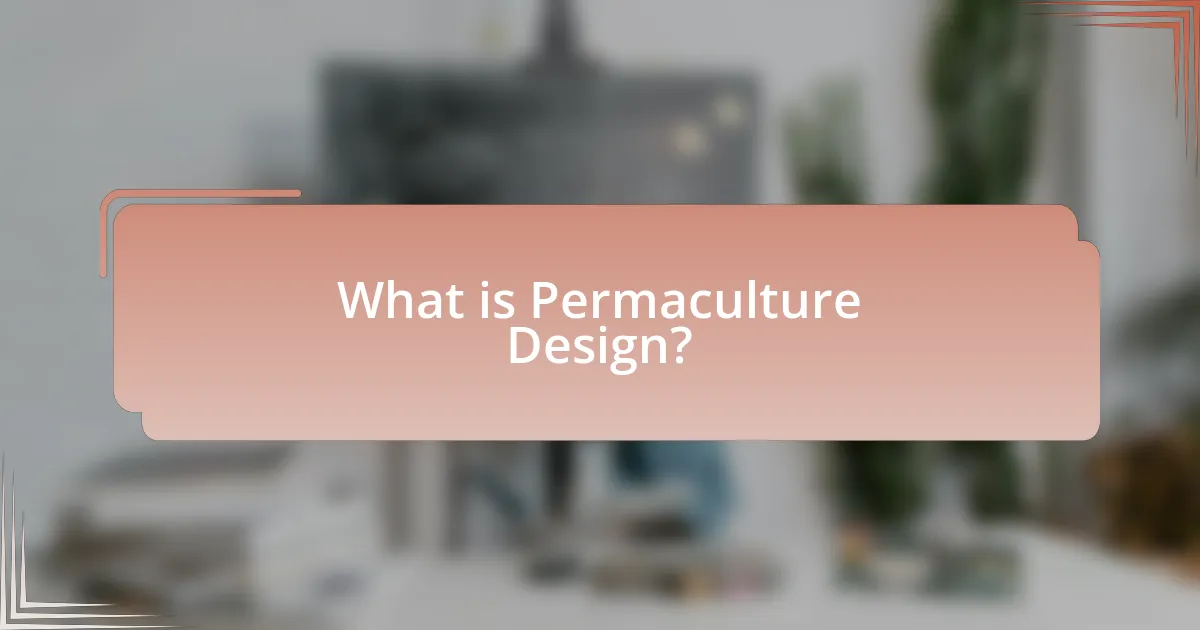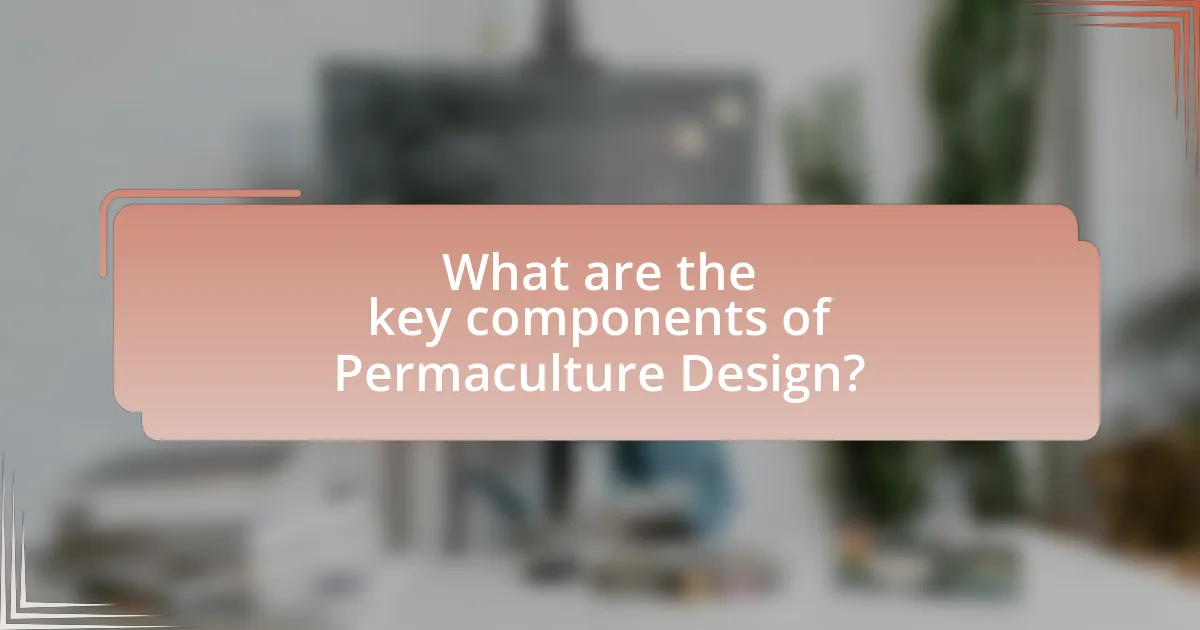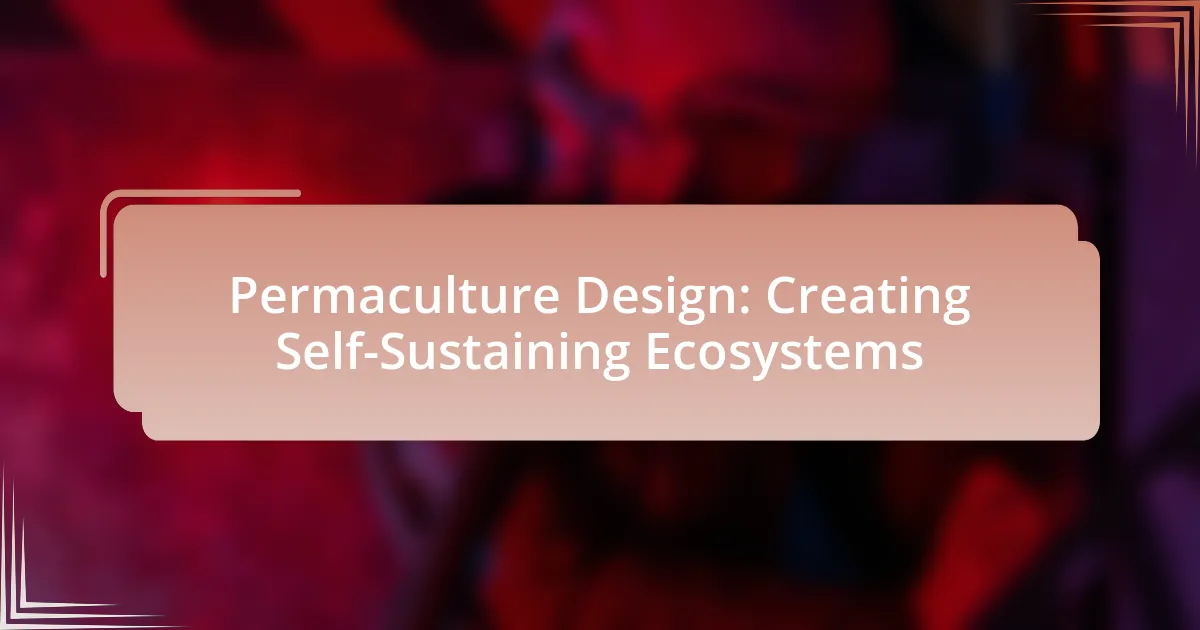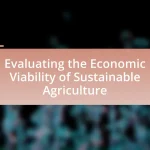Permaculture design is a holistic approach to land management that aims to create sustainable and self-sufficient ecosystems by integrating plants, animals, buildings, and people in a manner that mimics natural systems. The article outlines the principles of permaculture, including observation, energy capture, and biodiversity enhancement, which collectively foster resilience and productivity in agricultural practices. It also addresses the environmental challenges permaculture seeks to mitigate, such as soil degradation and water scarcity, while highlighting the importance of effective resource management through zoning and sector analysis. Additionally, the article discusses the roles of plants and animals in permaculture systems, best practices for implementation, and strategies for maintaining long-term sustainability and productivity.

What is Permaculture Design?
Permaculture design is a holistic approach to land management and agricultural systems that seeks to create sustainable and self-sufficient ecosystems. This design methodology integrates various elements such as plants, animals, buildings, and people in a way that mimics natural ecosystems, promoting biodiversity and resilience. The principles of permaculture design are grounded in ethics and practical strategies, emphasizing care for the earth, care for people, and fair share of resources. Evidence of its effectiveness can be seen in numerous successful permaculture projects worldwide, which demonstrate improved soil health, increased food production, and enhanced ecological balance.
How does Permaculture Design create self-sustaining ecosystems?
Permaculture Design creates self-sustaining ecosystems by integrating natural processes and biodiversity to enhance resilience and productivity. This approach utilizes principles such as observing and mimicking natural ecosystems, which leads to efficient resource use and waste reduction. For example, permaculture systems often incorporate companion planting, where different plants support each other’s growth, thus minimizing the need for chemical fertilizers and pesticides. Additionally, permaculture emphasizes the use of renewable resources, such as rainwater harvesting and composting, which further contributes to sustainability. Research has shown that these practices can significantly improve soil health and increase crop yields, demonstrating the effectiveness of permaculture in creating self-sustaining ecosystems.
What principles underpin Permaculture Design?
Permaculture Design is underpinned by principles such as observing and interacting with nature, capturing and storing energy, obtaining a yield, and applying self-regulation and feedback. These principles guide the creation of sustainable and self-sufficient ecosystems. For instance, the principle of observing and interacting emphasizes understanding local ecosystems to design effective systems, while capturing and storing energy focuses on utilizing resources like sunlight and rainwater efficiently. These foundational principles are essential for developing resilient agricultural practices and sustainable living environments.
How do these principles interact to form a cohesive system?
The principles of permaculture interact to form a cohesive system by emphasizing the interconnectedness of ecological, social, and economic factors. These principles, such as observing and interacting, using renewable resources, and valuing diversity, work together to create resilient ecosystems. For instance, by integrating diverse plant species, permaculture enhances biodiversity, which in turn supports soil health and pest management, leading to a more sustainable agricultural system. Research by David Holmgren, co-founder of permaculture, highlights that these principles are designed to mimic natural ecosystems, thereby fostering a balance that promotes sustainability and resilience.
Why is Permaculture Design important for sustainability?
Permaculture design is important for sustainability because it creates self-sustaining ecosystems that mimic natural processes. This approach enhances biodiversity, improves soil health, and conserves water, leading to resilient agricultural systems. For instance, studies show that permaculture practices can increase crop yields by up to 30% while reducing the need for chemical fertilizers and pesticides, thereby minimizing environmental impact. By integrating various elements such as plants, animals, and water systems, permaculture fosters a balanced ecosystem that supports both human needs and ecological health.
What environmental challenges does Permaculture Design address?
Permaculture Design addresses several environmental challenges, including soil degradation, water scarcity, loss of biodiversity, and climate change. By implementing sustainable agricultural practices, permaculture enhances soil health through techniques like composting and crop rotation, which restore nutrients and prevent erosion. It also promotes efficient water management through rainwater harvesting and swales, mitigating the effects of drought. Furthermore, permaculture fosters biodiversity by creating diverse ecosystems that support various plant and animal species, thus enhancing resilience against pests and diseases. Lastly, permaculture practices contribute to climate change mitigation by sequestering carbon in soil and vegetation, reducing greenhouse gas emissions associated with conventional farming.
How does Permaculture Design contribute to biodiversity?
Permaculture Design contributes to biodiversity by creating diverse ecosystems that mimic natural processes. This design approach integrates various plant and animal species, enhancing habitat complexity and resilience. For instance, permaculture systems often include polycultures, which combine multiple crops that support each other, leading to improved soil health and pest control. Research indicates that such diversity can increase ecosystem productivity and stability, as seen in studies demonstrating that diverse agricultural systems yield higher outputs compared to monocultures. Additionally, permaculture practices promote native species and beneficial insects, further supporting local biodiversity and ecological balance.

What are the key components of Permaculture Design?
The key components of Permaculture Design include observation, zones, sectors, and the use of patterns. Observation is crucial as it allows designers to understand the natural environment and its dynamics. Zones refer to the spatial arrangement of elements based on their frequency of use and energy needs, optimizing efficiency. Sectors analyze external energies such as wind, sun, and water flow that impact the site. Patterns help in recognizing recurring themes in nature, guiding the design process. These components work together to create sustainable and self-sufficient ecosystems, as evidenced by successful permaculture projects worldwide that demonstrate increased biodiversity and resource efficiency.
How do zones and sectors influence Permaculture Design?
Zones and sectors significantly influence Permaculture Design by organizing space and resources to optimize energy use and productivity. Zones refer to the spatial arrangement of elements based on their frequency of use and maintenance needs, with Zone 1 being the most intensively managed area close to the home, while Zone 5 is left wild for biodiversity. Sectors, on the other hand, analyze external factors such as sun, wind, and water flow that impact the site, allowing designers to position elements strategically for maximum benefit. For instance, placing a greenhouse in a sunlit sector enhances plant growth, while positioning windbreaks in the path of prevailing winds protects crops. This structured approach ensures efficient resource management and promotes sustainable practices, ultimately leading to resilient ecosystems.
What are the different zones in a Permaculture system?
In a Permaculture system, there are typically five distinct zones, each designed to optimize energy use and resource management. Zone 0 is the home or central living area, where human activity is concentrated. Zone 1 includes the immediate surroundings of the home, where intensive gardening and daily activities occur. Zone 2 is designated for less frequently accessed areas, such as larger gardens and small livestock. Zone 3 consists of more extensive agricultural areas that require less maintenance, like orchards and larger crops. Zone 4 serves as a semi-wild area for foraging and timber production, while Zone 5 is a natural wilderness area, left untouched to support biodiversity and ecological processes. This zoning system is based on the principle of placing elements according to their frequency of use and energy needs, promoting efficiency and sustainability in design.
How do sectors affect resource management in Permaculture?
Sectors in permaculture influence resource management by determining how energy, water, and nutrients flow within a system. These sectors, which include elements like sun exposure, wind patterns, and water sources, help in strategically placing plants, animals, and structures to optimize resource use. For instance, positioning a garden in a sector that receives maximum sunlight enhances plant growth and reduces the need for artificial lighting. Additionally, understanding wind sectors allows for the placement of windbreaks, which can protect crops and reduce water evaporation. This strategic alignment of resources based on sector analysis leads to more efficient and sustainable management practices, ultimately fostering a self-sustaining ecosystem.
What role do plants and animals play in Permaculture Design?
Plants and animals are integral components of Permaculture Design, as they contribute to the creation of self-sustaining ecosystems. Plants provide essential functions such as soil stabilization, nutrient cycling, and habitat creation, while animals contribute through pest control, pollination, and nutrient distribution. For instance, legumes fix nitrogen in the soil, enhancing fertility, and chickens can help manage pests and provide manure that enriches the soil. This symbiotic relationship between plants and animals fosters biodiversity, resilience, and productivity within the ecosystem, aligning with the principles of permaculture that emphasize working with nature rather than against it.
Which plants are best suited for Permaculture systems?
The best plants suited for Permaculture systems include nitrogen-fixing plants, perennial vegetables, and fruit trees. Nitrogen-fixing plants, such as clover and legumes, enhance soil fertility by converting atmospheric nitrogen into a usable form for other plants. Perennial vegetables like asparagus and rhubarb provide continuous yields without the need for annual replanting, promoting sustainability. Fruit trees, such as apple and pear, contribute to biodiversity and provide food over multiple seasons. These plant types are integral to creating self-sustaining ecosystems, as they support soil health, reduce maintenance, and enhance overall productivity in Permaculture designs.
How can animals be integrated into Permaculture Design?
Animals can be integrated into Permaculture Design by utilizing their natural behaviors to enhance ecosystem functions. For instance, chickens can be used for pest control and soil aeration, while goats can manage weeds and provide manure that enriches the soil. Research indicates that integrating livestock into permaculture systems can improve biodiversity and soil health, as demonstrated in studies showing increased crop yields and reduced need for chemical fertilizers when animals are included in the design. This approach not only supports sustainable agriculture but also creates a balanced ecosystem where animals contribute to the overall productivity and resilience of the system.

How can one implement Permaculture Design effectively?
To implement Permaculture Design effectively, one must observe and interact with the environment to understand its natural patterns and processes. This foundational step allows for the design of systems that mimic these patterns, promoting sustainability. For instance, utilizing zone planning, where elements are placed according to their frequency of use, optimizes energy efficiency and resource management. Research indicates that permaculture systems can increase biodiversity and soil health, as demonstrated in studies like “Permaculture: A Sustainable Approach to Land Use” by Bill Mollison, which highlights the benefits of integrating diverse plant species to enhance ecosystem resilience.
What steps are involved in creating a Permaculture design plan?
Creating a Permaculture design plan involves several key steps: site analysis, design principles application, and implementation planning. First, site analysis requires assessing the land’s climate, topography, soil, and existing ecosystems to understand its unique characteristics. Next, applying design principles involves integrating elements such as zones, sectors, and patterns to create a sustainable system that mimics natural ecosystems. Finally, implementation planning outlines the specific actions, timelines, and resources needed to establish the design, ensuring that the plan is practical and achievable. These steps collectively facilitate the development of a self-sustaining ecosystem that meets human needs while enhancing biodiversity.
How do you assess land for Permaculture suitability?
To assess land for Permaculture suitability, evaluate the site’s climate, soil quality, water availability, and topography. Climate analysis involves understanding temperature ranges, rainfall patterns, and seasonal variations, which influence plant growth and ecosystem health. Soil quality assessment includes testing for pH, nutrient levels, and organic matter content, as healthy soil is crucial for sustainable agriculture. Water availability is determined by examining natural water sources, drainage patterns, and irrigation potential, as water is essential for plant survival. Topography assessment involves analyzing land slope and orientation, which affect sunlight exposure and water runoff. These factors collectively inform the land’s capacity to support diverse, self-sustaining ecosystems, aligning with Permaculture principles.
What tools and resources are essential for Permaculture design?
Essential tools and resources for Permaculture design include soil testing kits, design software, and native plant guides. Soil testing kits allow practitioners to assess soil health and nutrient levels, which is crucial for effective planting and crop management. Design software, such as Permaculture design tools, helps in creating layouts that optimize land use and resource management. Native plant guides provide information on local flora, aiding in the selection of plants that thrive in specific environments and support biodiversity. These resources collectively enhance the effectiveness of Permaculture practices by ensuring informed decision-making and sustainable ecosystem management.
What common challenges arise in Permaculture Design?
Common challenges in Permaculture Design include soil degradation, water management, biodiversity loss, and climate variability. Soil degradation often results from unsustainable agricultural practices, leading to reduced fertility and erosion. Effective water management is crucial, as improper irrigation can cause water scarcity or flooding. Biodiversity loss occurs when ecosystems are not designed to support a variety of species, which can destabilize the system. Additionally, climate variability poses a challenge, as changing weather patterns can affect crop yields and ecosystem resilience. These challenges require careful planning and adaptive strategies to create successful self-sustaining ecosystems.
How can one overcome obstacles in implementing Permaculture?
To overcome obstacles in implementing Permaculture, one should focus on education and community engagement. Educating oneself about Permaculture principles and practices equips individuals with the knowledge to address challenges effectively. For instance, understanding soil health, water management, and biodiversity can lead to better decision-making in design and implementation. Community engagement fosters collaboration, allowing individuals to share resources, experiences, and solutions. Research indicates that community-supported agriculture initiatives have successfully increased local food production and resilience, demonstrating the effectiveness of collective efforts in overcoming implementation barriers.
What are the most frequent mistakes made in Permaculture Design?
The most frequent mistakes made in Permaculture Design include inadequate site analysis, poor plant selection, and neglecting water management. Inadequate site analysis often leads to designs that do not consider local climate, soil conditions, and existing ecosystems, resulting in ineffective systems. Poor plant selection can occur when designers fail to choose species that are well-suited to the local environment, which can hinder growth and sustainability. Neglecting water management, such as not implementing proper drainage or irrigation systems, can lead to water scarcity or flooding, undermining the entire design. These mistakes are commonly observed in various permaculture projects, emphasizing the importance of thorough planning and understanding of ecological principles.
What are best practices for maintaining a Permaculture system?
Best practices for maintaining a Permaculture system include regular observation, soil health management, biodiversity enhancement, and efficient water use. Regular observation allows practitioners to understand ecosystem dynamics and make informed adjustments. Soil health management, such as composting and mulching, improves nutrient availability and structure, which is essential for plant growth. Enhancing biodiversity through companion planting and habitat creation supports pest control and pollination, leading to a more resilient system. Efficient water use, achieved through techniques like swales and rainwater harvesting, conserves resources and ensures plants receive adequate moisture. These practices collectively contribute to the sustainability and productivity of Permaculture systems.
How can one ensure long-term sustainability in Permaculture Design?
To ensure long-term sustainability in Permaculture Design, one must implement diverse and resilient ecosystems that mimic natural processes. This involves integrating various plant and animal species to create symbiotic relationships, which enhance soil health, improve water retention, and increase biodiversity. Research indicates that polycultures, where multiple species coexist, can lead to greater resilience against pests and diseases compared to monocultures, as demonstrated in studies by the Rodale Institute, which found that diverse cropping systems can yield 20% more than conventional systems while using fewer resources. Additionally, employing techniques such as water harvesting, composting, and agroforestry contributes to sustainable practices by recycling nutrients and conserving resources.
What tips can enhance the productivity of a Permaculture ecosystem?
To enhance the productivity of a Permaculture ecosystem, implement diverse planting strategies, such as polycultures and companion planting, which promote biodiversity and resilience. Research indicates that diverse plantings can lead to improved soil health and pest management, as seen in studies like “The Role of Biodiversity in Ecosystem Functioning” by Hector et al., published in Nature. Additionally, integrating animals into the system can aid in nutrient cycling and pest control, further boosting productivity. Utilizing techniques like mulching and cover cropping can improve soil structure and moisture retention, which are critical for plant growth.


